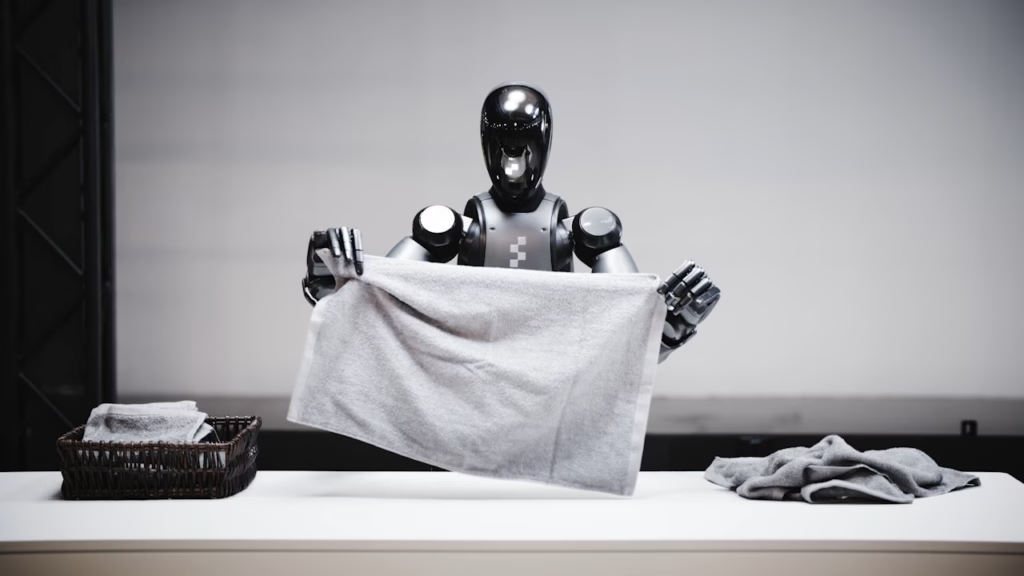
When you think about folding laundry, it probably doesn’t seem like a big deal. Most of us can do it without even thinking, grab a towel, smooth it out, fold it over, and stack it neatly. But for a humanoid robot, this is one of the toughest challenges it can face.
Figure’s humanoid robot, powered by its Vision Language Action (VLA) model called Helix, has just pulled off something amazing. After proving it could handle an hour of fully autonomous package sorting in a busy logistics setting, Helix has now turned its attention to something far more domestic—folding laundry. And not just any laundry. Towels.
If you’ve ever tried to fold a towel perfectly, you know they don’t always cooperate. They’re soft, flexible, and always changing shape. They bend, wrinkle, and sometimes tangle into awkward bunches. There’s no exact shape to memorize and no single right way to hold them. Even the slightest slip of your fingers can send the whole thing sliding to the floor.
For a human, our brains and fingers work together naturally to adapt in real time. We don’t consciously think about how to pinch a corner or smooth out an edge. For a robot, however, this requires an incredible level of skill and precision. And that’s exactly what makes Helix’s latest achievement so exciting.
Why Folding Laundry Is So Hard for Robots
Folding a towel is a lot more complicated for a robot than, say, picking up a box or placing something on a shelf. Boxes are solid and predictable. They don’t change shape when you touch them, and they always have the same edges and corners.
Towels, on the other hand, are what engineers call “deformable.” This means their shape changes constantly. A robot can’t just memorize a towel’s layout—it has to adjust in real time based on what’s in front of it. The robot’s vision system needs to understand not just where the towel is, but how it’s moving, folding, or wrinkling at any given moment.
Then comes the dexterity problem. It’s not enough to simply grab the towel. Helix has to trace its edges with a thumb, pinch its corners, smooth out wrinkles, and adapt instantly if the fabric slips or folds the wrong way. This kind of control requires perfectly coordinated movements between fingers, hands, and eyes—something robots have always struggled with.
A First for Humanoid Robots
What makes this moment special is that Helix is the first humanoid robot with multi-fingered hands to fold laundry completely on its own using a single end-to-end neural network. No one had ever pulled that off before.
Even more impressive is how Helix learned the skill. The exact same model that was used for package sorting was applied directly to laundry folding—without changing the architecture or tweaking any of the training settings. The only thing that changed was the dataset. Helix didn’t need special programming for towels. It simply learned by seeing enough examples.
That means we’re looking at a general-purpose brain for robots—one that can switch from industrial work to household chores without being rebuilt from scratch.
How Helix Learned to Fold Towels
Helix’s training was all about observation, adaptation, and repetition. The model was fed new data showing how towels behave when picked up, folded, and stacked. Over time, it learned the small but important details—like how to handle corners without letting the whole towel bunch up, and how to recover if it accidentally picked up two towels at once.
One of the most remarkable things about Helix is that it works without building detailed object-level representations. For rigid objects, having a clear 3D model in memory works fine. But for something soft and constantly changing like a towel, that approach would be fragile and unreliable. Helix skips that step entirely. Instead, it processes what it sees and hears, then directly controls its hands and fingers in a smooth, precise way.
During folding, Helix can Pick towels from a mixed pile. Adjust its folding strategy based on how the towel starts out. Return extra items if it grabs more than one by mistake. Untangle towels that have gotten twisted together.
And it does all of this while keeping a natural, human-like interaction with the people around it. Helix can make eye contact, look in the right direction, and even use learned hand gestures when communicating—something that makes the robot feel more approachable and less like a cold machine.
From the Warehouse to the Living Room
Perhaps the most exciting part of this story is what it means for the future. Helix has shown it can go from handling industrial packages to folding laundry with the exact same brain and body. That’s a big leap toward truly general-purpose humanoid robots—machines that can handle a huge variety of real-world tasks without needing major redesigns or retraining.
As Figure collects more real-world data, Helix’s abilities are expected to grow. That means faster folding, smoother movements, and the ability to handle even more complex tasks, both in industrial settings and at home.
This progress isn’t just about laundry or warehouses—it’s about building robots that can help in almost any environment. Imagine a single robot that can move from stocking shelves in a store, to unloading delivery trucks, to helping out in your kitchen, all without needing a complete software overhaul.
The Road Ahead for Humanoid Intelligence
Helix’s achievement is a clear sign that we’re getting closer to practical, everyday humanoid robots. While there’s still a long way to go, each new skill brings us closer to a future where robots can take on a wide range of jobs in our lives.
For now, folding towels might seem like a small victory. But in robotics, these small victories are huge stepping stones. Every wrinkle smoothed and every corner folded represents progress toward the ultimate goal—robots that can adapt and work anywhere, just like humans do.
Source: Figure AI

